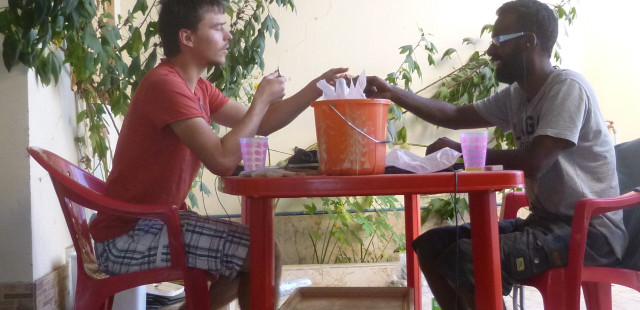Excavations of the Iron Age sites of Bithnah and Masafi (Emirate of Fujairah) have uncovered several functionally and spatially distinct contexts: Bithnah-23 and Masafi-2 are both fortified settlements with private residences; Masafi-1 and Building B at Bithnah-44 have been identified as collective buildings where meetings took place; and Masafi-3 as well as several smaller features around Building B at Bithnah (Buildings J and K, altar L, altar H) could be interpreted as places of ritual activities.

Fig. 1. Localisation of Bithnah and Masafi (Map : S. Karacic).
Each of these different contexts has provided a distinctive set of vessels. Storage jars with lids, large basins and large bowls, and medium neck-jars or bottles, often with suspension lugs dominate the ceramic assemblages of the fortified settlements. In the largest rooms of the collective buildings, where meetings and ceremonies took place, small bowls and spouted jugs are particularly well represented, often in association with a few footed vessels and one large vessel with a lid with several perforations. The ritual areas include numerous footed vessels and bowls with a single long horizontal handle, whereas jugs, small or large jars and lids appear in smaller quantities. In these places many vessels are decorated with appliqués in relief representing a snake.
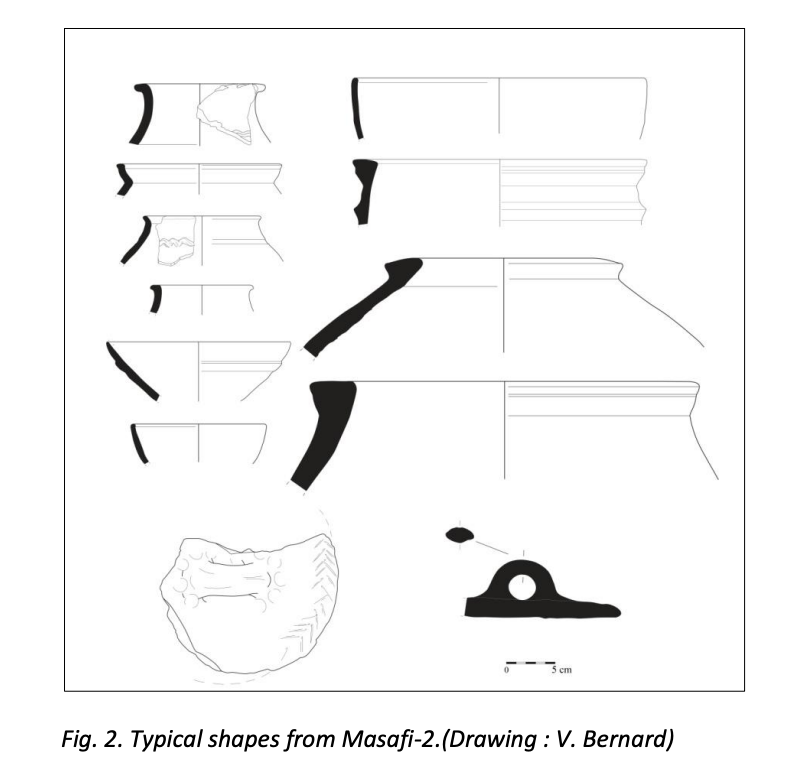


These different assemblages of pottery from Bithnah and Masafi are all characterized by a fabric of orange color, with a fine temper or for the coarsest with red and white grits visible in the paste. But these orange fabrics compose a heterogeneous group, some of them appearing particularly soft and friable, others appearing harder, better fired and more compact.
A program of petrographic and chemical analyses of the pottery commenced in 2017 with financial support from the BFSA. Its aim is to compare the composition of vessels collected in domestic contexts, collective buildings and ritual areas in order to test the possibility that different chaines opératoires working in the same time in the same place produced functionally different vessels for consumption in each of these three distinct social spaces.
The first phase of our study focused on the sampling and exporting of the material. In order to expedite analysis, two samplings were made of the Masafi pottery, one which was exported to France for petrographic analyses and the other to the USA for instrumental neutron activation analysis (INAA). In total 144 potsherds from Masafi were sampled: 36 from Masafi-2, 41 from the ritual area of Masafi-3 and 67 from the collective building of Masafi-1. From Bithnah, 19 ritual vessels and 21 domestic vessels were sampled, mainly from the site of Bithnah-44 where the collective building and the ritual features are located. All exported samples were described and photographed, and the majority of the samples were drawn as part of a previous study.
Petrographic study: preliminary results
Thin sections were prepared for 30 samples from Masafi at the Laboratorio Petrographico Di Canepa Pierluigi in Italy (see table 1).
Preliminary study of this material, conducted in Paris in June 2017) and rennes in December 2017, identified 6 groups, provisionally.
Group 1 (n=4: S03, S13, S20, S34) is mainly composed of ritual vessels. Three samples are from Masafi-3, all with decorations of snake appliqué. They include a footed vase, a medium jar and a potsherd with a snake emerging from a vase the shape of which is unknown. The last sample registered in this group is a fragment of a basin from the collective building Masafi-1.The four samples are macroscopically characterized by a pale orange to buff orange color. Samples can be fully or not fully oxidized.
Microscopically, one of the main characteristic of Group 1 is its meshed structure, with a matrix composed of a fine mixing of micas and clay minerals. Contraction of the clay has created very thin and long pores along aggregates of clayish phyllites.
The fine temper fraction is mainly composed of quartz crystals, sub-angular to sub-rounded and rather well sorted. Potassium-feldspars, plagioclases, rounded opaque minerals rich in iron oxides are present as well as vestiges of sub-rounded micritic carbonates including very recrystallized fossils, and fragments of sparry calcite or single crystals of calcites.
The coarse temper fraction of (1-2 mm long) is very moderate to moderate in quantity. It comprises mainly composed of sub-rounded to rounded serpentinized olivines and pyroxenes, plus fragments of micritic limestone with vestiges of bioclasts (including recrystallized fossils), few quartz crystals and occasional feldspars. Few fragments of rocks including mainly quartz, plagioclases and biotites are recognized as well.
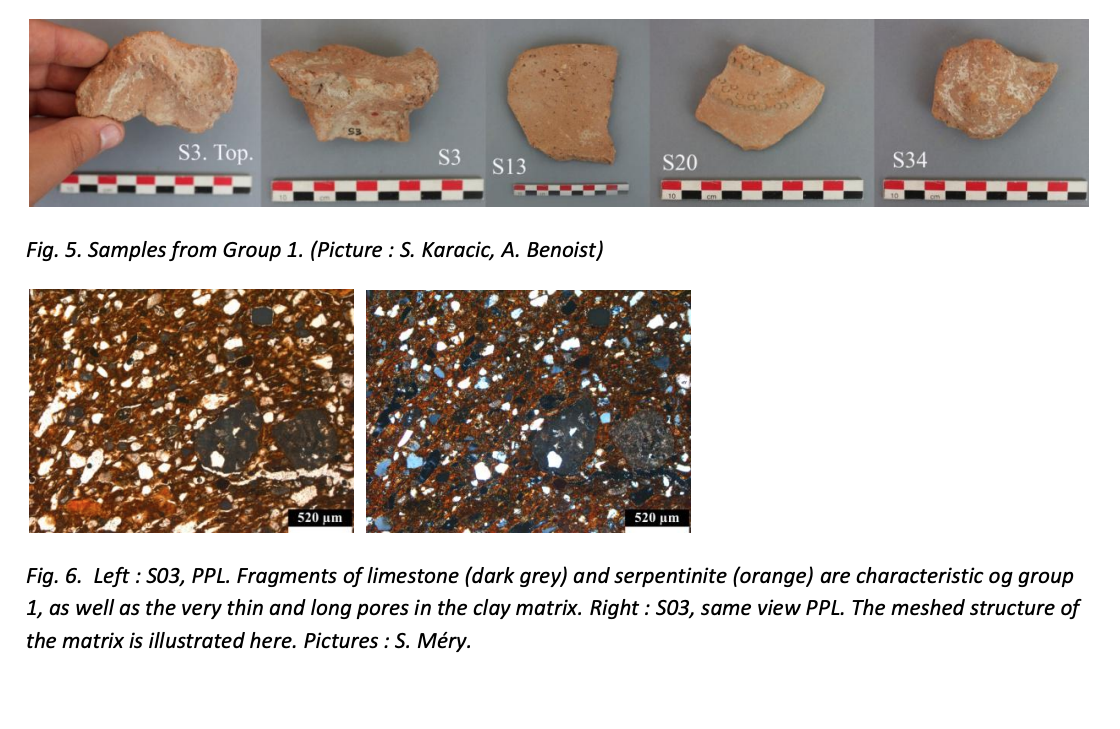

Group 2 (n=9: S2, S14, S21, S22, S31, S33, S36, S37, S38) also mainly includes ritual ware from Masafi3. Seven Fragments are decorated with snakes appliqué, one presents an ‘M-shaped’ decoration on the rim that could be an abstracted version of a snake head. Only one member of Group 2 has no snake decoration. Group 2 includes 8 samples of rims of footed vases or handled bowls coming from Masafi-3, all of which have snake appliqué. The shape without any snake decoration is a small jar recovered from the collective building of Masafi-1 (S14). It is the only vessel that does not come from a ritual context.
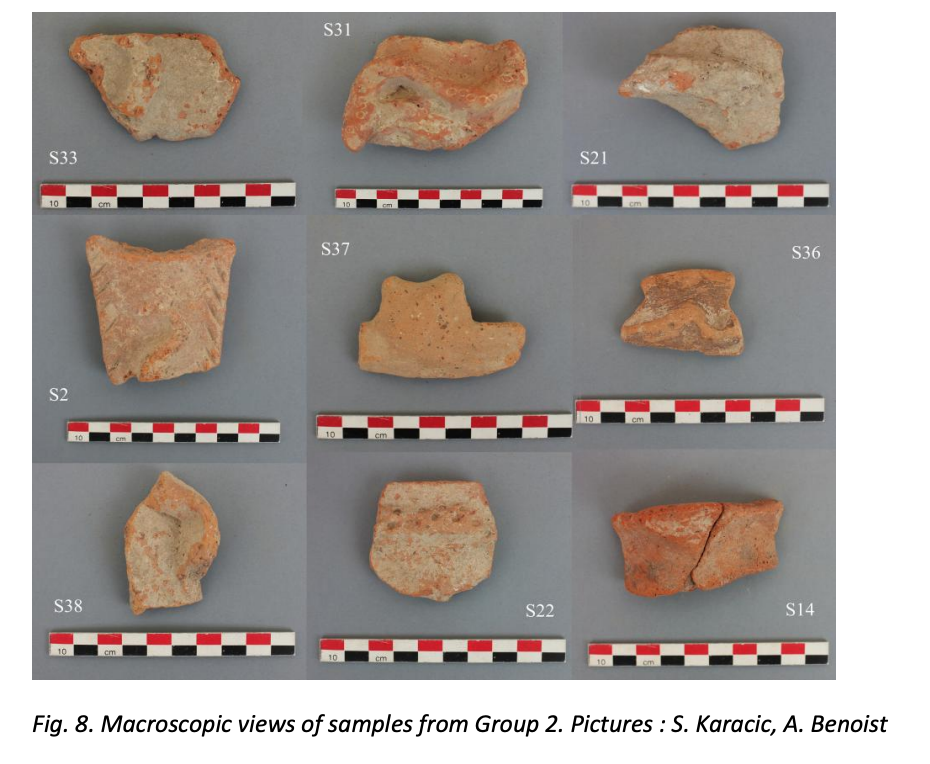
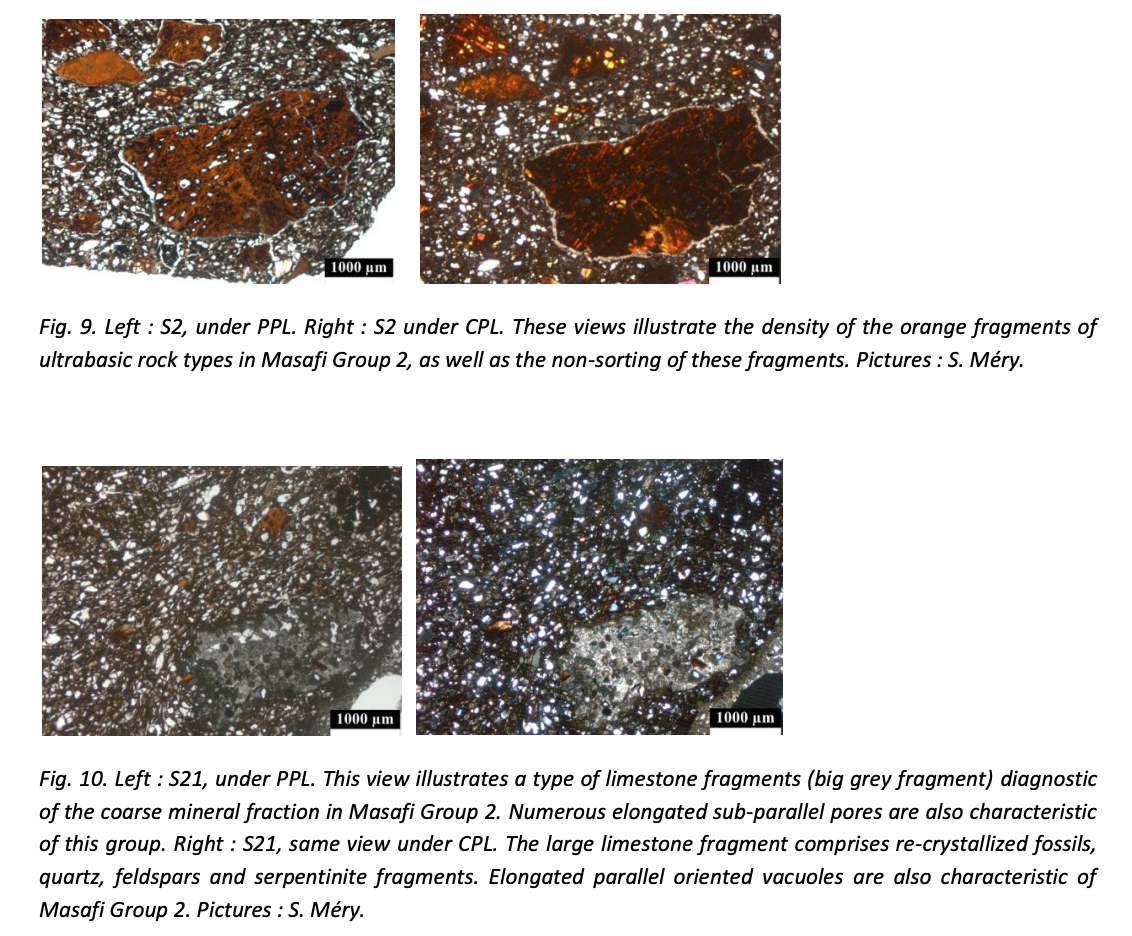
Group 2 is macroscopically characterized by a bright orange color. The paste is generally fully oxidized, brown-red in plain polarized light and red-brown with low optical activity in crossed polars light (CPL).
Characterized by a low optical activity, the matrix shows signs of a strong contraction (during the drying and the beginning of the firing) with elongated porosities along aggregates of clayey phyllites, but different from the organization
The fine mineral fraction is mainly composed of quartz and micritic rounded carbonates including vestiges of recrystallized fossils. The quartz are slightly smaller, less calibrated, a bit sharper and more irregular in shape than those of the finest temper of Group 1. Sub-rounded to rounded fragments of ultramafic serpentinites including serpentinized olivines and opaque fragments. White elongated micas (muscovite) are visible. Sub-automorphic pyroxenes and basaltic hornblendes are rarely visible in some of the thin-sections of Group 2.
The coarse temper fraction is abundant to moderate, in some case rather large (until 3-4 mm) and non-sorted. It comprises mainly sub-rounded to rounded fragments of ultramafic serpentinites (including serpentinized olivines), but compared to Group 1 the serpentine is very strongly colored in orange to dark red and the relics of the primary minerals infrequent. Fragments of micritic limestones are present. Some fragments of limestone include (like in Group 1) vestiges of bioclasts (re-crystallized fossils), quartz and feldspars crystals or even serpentinized olivines varying in quantity from one sample to the next. Also visible are some fragments of a metamorphic rock composed mainly of quartz, plagioclases and biotites.
Group 3 (n=5: S6, S8, S12, S32, S71) includes fragments of bowls (some painted) and a small jug from Masafi-1, to which is added a single sherd decorated with snake appliqué collected in Masafi-3. This group very close to group 2, is a finer variant.
Like group 2, the paste is generally fully oxidized, very rich in iron oxides, brown-red in plain polarized light (PPL) and red brown with low optical activity in polarized light (CPL).
The fine fraction of temper is similar to the one encountered in group 2, mainly composed of quartz crystals and micritic sub-rounded carbonate grains, the latter including vestiges of recrystallized fossils. Like in group 2, quartz inclusions are slightly smaller, sharper and more irregular than in group 1, and sub-rounded to rounded serpentinized olivines and opaque fragments of rocks very rich in iron are observed as well as white elongated micas (muscovite).
Contrary to group 2, there is no or few coarse mineral temper fraction. When present it is dominated by strongly orange to dark red fragments of serpentinite.
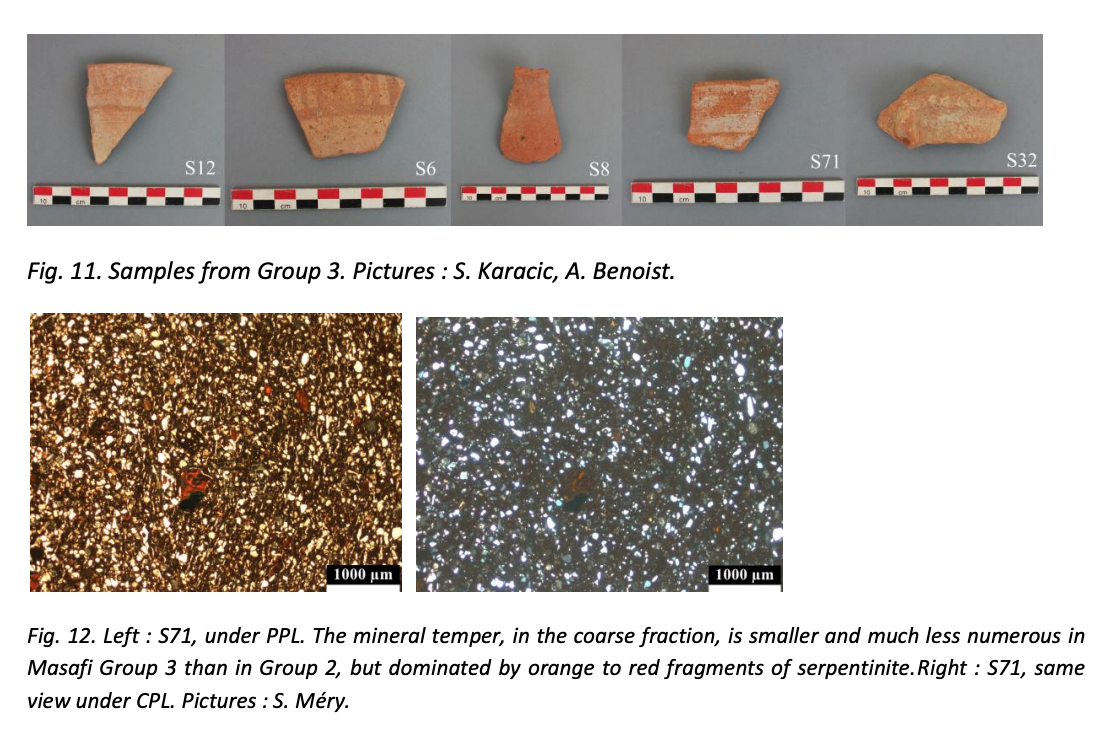
Group 4 (n=6: S10, S27, S39, S57, S68, S77) is more heterogeneous. Three fragments come from Masafi-1 and belong to a neck jar, a small carinated bowl and a bowl with multiple ribs. Two fragments come from Masafi-2 and belong to a bowl with multiple ribs and a storage jar. A single fragment belongs to a footed brazier from Masafi-3. This group is characterized by a fully oxidized paste (except one sample, S68) very rich in iron oxides. The matrix is light orange in plain polarized light. It is a mixing of micas and argillaceous phyllites more or less oriented under crossed polars light. The optical activity is better than in Group 2, with a wavy extinction . Like in group 2 the matrix reflects important contraction and includes elongated vacuoles along the aggregates of clayish phyllites.
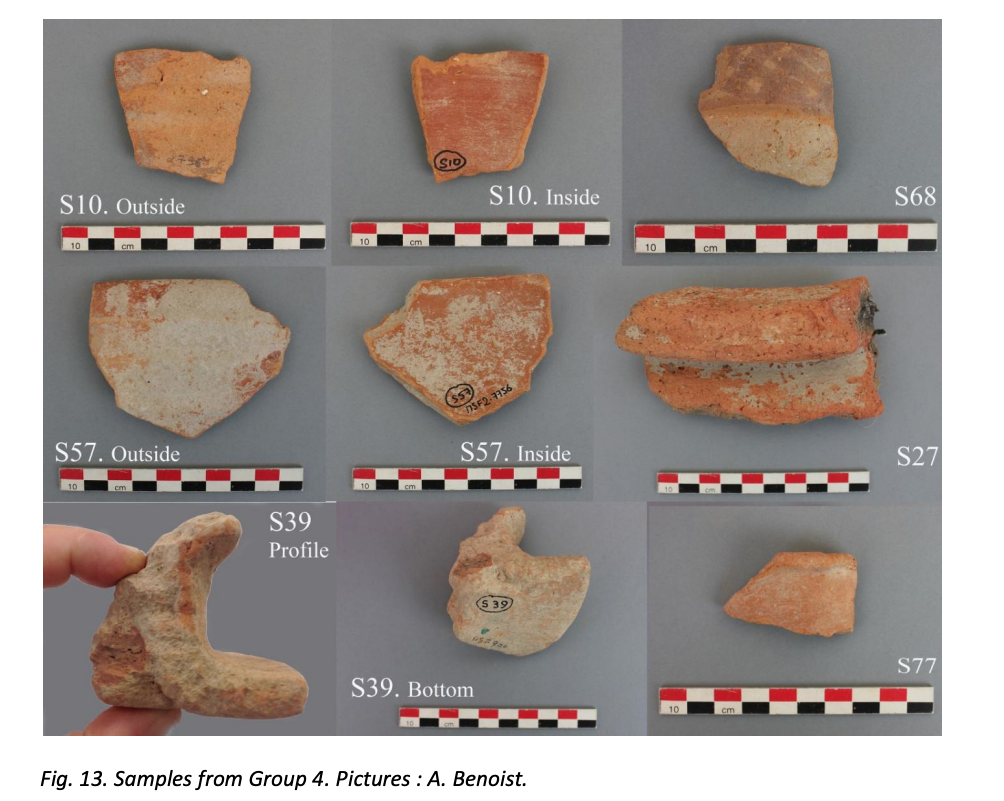

The fine temper fraction is mainly composed of quartz crystals (similar to the ones of Groups 2 and 3) and remains of serpentinite strongly colored by iron oxides. Fragments of sub-rounded micritic carbonates are present in S57 and S68, including remains of recrystallized fossils. No sparry calcite or single crystals of calcite are identified. Sub-rounded to rounded serpentinized olivines and opaque fragments of rocks very rich in iron are frequent. White elongated micas (possibly muscovite) are also present, and more frequent than in Group 1. Rare fragments of basaltic hornblende are visible. There is no coarse fraction of temper. Samples S39 and S27 are full of vegetal temper imprints. Sample S77 has a less vacuolar paste.
Group 5 (n=2: S17 and S30) is composed of two fragments of jars, one coming from Masafi-2 and the other collected on the surface in the palm-grove area. This group is characterized by an incompletely oxidized paste rich in iron oxides.
In plain polarized light the matrix is light orange with a thick grey core. It is a mixing of micas and clay phyllites more or less oriented under crossed polars light. The optical activity is better than in Group 2, the extinction of the matrix is wavy. Like in Group 2, the matrix shows traces of a strong contraction with elongated vacuoles along aggregates of clay phyllites.
There are two fractions of temper.
The fine mineral fraction is mainly composed of quartz and remains of serpentinite strongly colored by iron oxides. White elongated micas (muscovite) are visible.
The coarse mineral fraction is close to the one of Group 2 (until 5 mm, and non-sorted). It comprises mainly sub-rounded to rounded serpentinite fragments, but a few serpentinized gabbro and peridotite fragments. As in Group 2, the serpentinite is strongly colored in orange to dark red. As in Groups 1 and 2 fragments of micritic limestones include vestiges of bioclasts (re-crystallized fossils), quartz and serpentinite fragments. A fragment of a metamorphic rock including mainly quartz, plagioclases and biotites is visible in S30. Sample S17 presents many secondary carbonates.
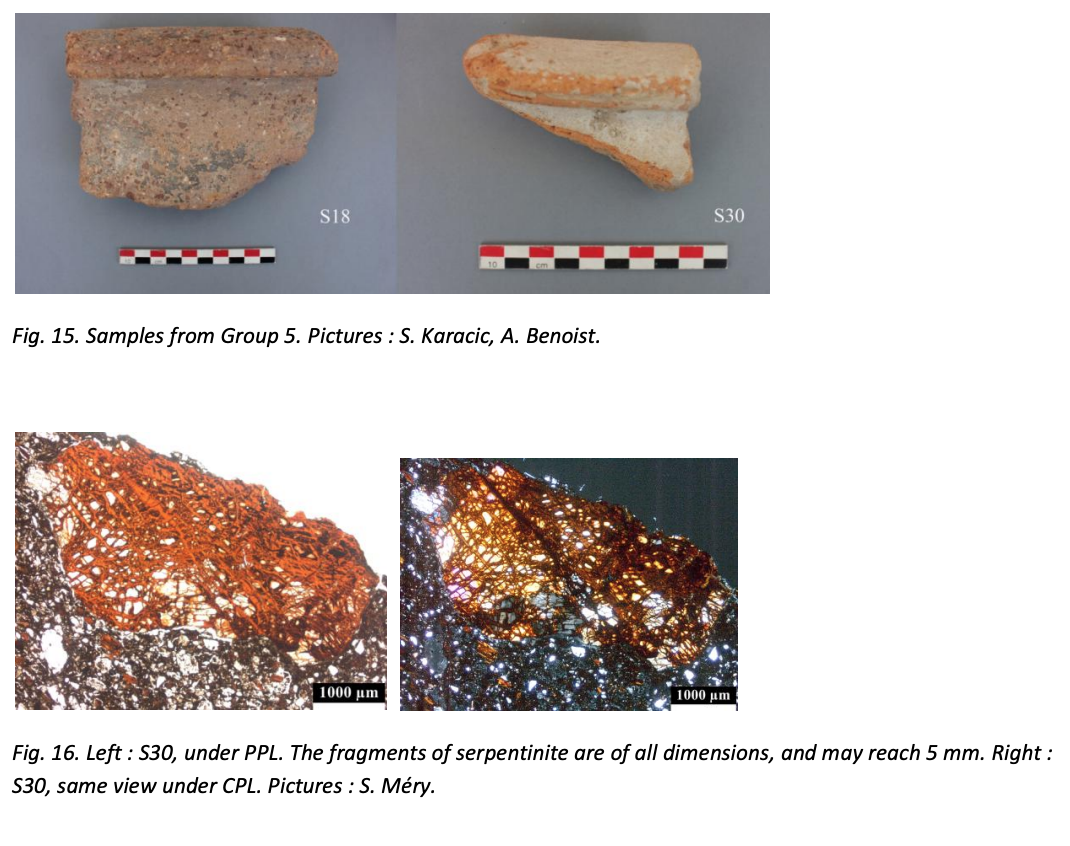
Group 6 (n=3: S4, S15, S70) includes two fragments of vessels from Masafi-1, a bowl and a neck jar, and a fragment of a neck jar from a surface collection in the palm-grove area. This group is characterized by a fully oxidized paste.
The matrix is pale brown-grey under plain polarized light and pale brown, marbled, with low optical activity under crossed polars light. It is a mixing of clay minerals and ultra-microscopic carbonates. Like in the previous groups, the matrix reflects a strong contraction, presenting elongated vacuoles along aggregates of clay phyllites. There are also many secondary carbonates until the core of the paste-ware.
The fine mineral fraction is mainly composed of beige to grey micritic rounded carbonates. Among the latter, vestiges of recrystallized fossils are visible. Quartz inclusions are identical to the ones of Group 2. Sub-rounded to rounded serpentinite fragments are also frequent. Isolated radiolaria, fragmented plagioclase crystals and a few white micas (possibly muscovite) are also present. Subautomorphic pyroxenes and basaltic hornblendes are rarely visible.
The coarse fraction is as abundant as in Group 2, similarly sorted and comprises the same types of rock fragments : sub-rounded to rounded serpentinites (with serpentinized olivines) strongly colored in orange to dark red, fragments of micritic limestones including re-crystallized fossils . Some fragments of a metamorphic rock including mainly quartz, potassium-feldspars, biotites, and muscovites are also present.
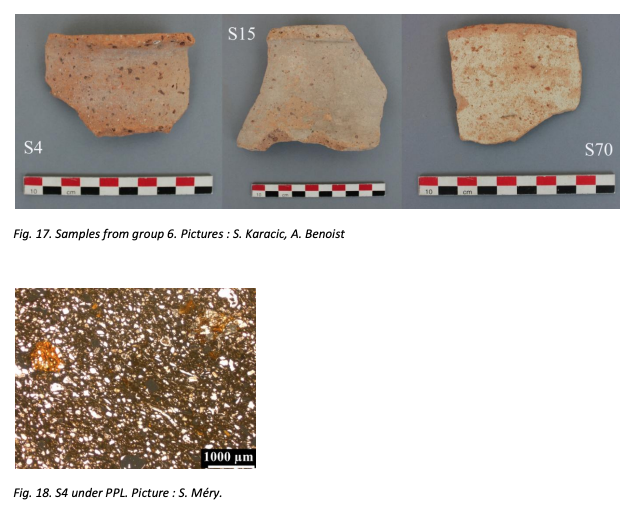
Unique sample S7 is a fragment of a bowl collected in Masafi-1. This group is close to Group 6, but without coarse fraction of temper.
The paste is fully oxidized, with a matrix pale brown grey in plain polarized light and pale brown, marbled, with low optical activity under crossed polars light. Secondary micritic carbonates impregnates the sherd until its core.
The main component of the fine temper fraction is beige to grey micritic rounded carbonates including vestiges of recrystallized fossils. Quartz inclusions are identical to the ones of Group 2. Subrounded to rounded fragments of serpentinites , and opaque fragments of rocks very rich in iron, are also frequent. Isolated radiolarian, fragmented plagioclases fragments and a few white micas (muscovite) are also present as well as sub-automorphic pyroxenes and basaltic hornblendes. There is no coarse fraction of temper.
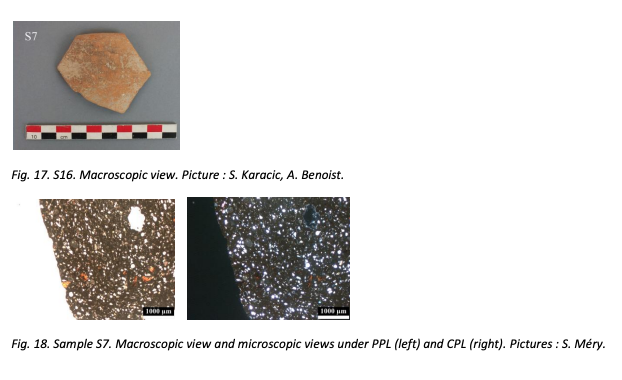
First conclusions
To conclude, our petrographic groups can be organized into several microfabrics, some of them with variants:
– Group 1 (‘micaceous’ matrix) is original, its clay is distinct from the one of the other Masafi microfabrics. This small group of four samples is almost entirely composed of ritual wares.
– The distinction between Groups 2, 3, and 4 (‘phylliteous’ matrix) is primarily related to the dimensions and the density of their coarsest mineral fraction. The finest wares are used primarily for the production of small bowls and jugs that were parts of drinking sets used during ceremonies in the collective buildings of Masafi-1, and the coarser variants composed mostly of vessels decorated with snakes and deposited in the small ritual area of Masafi-3. These three groups can be considered as specialized productions oriented to ritual or collective use, but Group 2 comprises also one jar. Group 5, with two samples of jars, is heavily tempered and close to Group 2. The composition of its clay fraction could be however slightly different, but the INAA chemical analysis will help to describe this difference, if confirmed.
– Group 6 (‘marly’ matrix) could belong to a third tradition of clay resource procurement and preparation. It mainly includes small bowls and medium neck-jars from the collective building of Masafi-1. These findings raise the possibility that the pottery was produced specifically for collective ceremonies in held in Masafi-1, but more samples must be studied in order to verify this hypothesis.
Despite these differences, the composition of the coarse fraction is close or similar whatever the group.
This composition groups are consistent with the geological environment surrounding Masafi, dominated by serpentinite formations (i.e. rock types formed by hydration and metamorphic transformation of ultramafic rocks from the ophiolite).
Therefore, all the Masafi pottery we analysed is likely to come from a region located in the nearby mountains. However, the location of the workshop (or workshops) remains to be determined.
Many questions remain regarding how the production of these different groups was organized. Was it the case that there were several workshops? Could the differences observed be the result of chronological differences?
The future petrographic study of vessels collected at Bithnah will complement the picture emerging from the analysis of the Masafi pottery. The ritual vessels collected at Masafi-3 are distinct from vessels collected in the ritual area of Bithnah, as pottery from the former site appears to have undergone limited or no use. Footed vessels and one-handled bowls, which represent the majority of the ritual pottery from Masafi-3, show scant or no traces of burning. Among them are also a number of very small vessels. Some footed vases and some handled bowls include snake applique on the inside which makes it unlikely that they were used as real braziers. Generally speaking it seems possible to consider these vessels as ex-votos deposited in Masafi-3 as opposed to vessels effectively used on site. These ex-votos might have been the result of a very specific production, maybe intended as a means of providing these ritual vessels to people wanting to make an offering. Such a situation was not observed at Bithnah where braziers show well-marked traces of burning and are generally larger in size.
Finally, after the preparation of thin sections, the remaining parts of the samples have been sent to the Archaeometry Laboratory at the University of Missouri Research Reactor (MURR) for INAA analyses. The results are expected in early 2018.
Bibliography
Benoist A. Dir, 2013 : La vallée de Bithnah au cours de l’Age du Fer. Society for Arabian Studies Monographs 14. BAR international Series Vol 2510.
Benoist A. 2010. Authority and religion in Eastern Arabia during the Iron Age (1150-250 BC). In A. Avanzini ed : Eastern Arabia during the first millennium BC. L’Erma di Brettschneider, Roma.
Benoist A. 2013 : A small green Paradise. Economic strategies, ritual practices and local ancestors of the Iron Age community of Masafi (Fujairah, United Arab Emirates). Proceedings of the Seminar for Arabian Studies 43: 47-62.
Benoist A. 2010 : Fouilles à Masafi-3 en 2009 (Emirat de Fujairah, E.A.U.) : Premières observations à propos d’un espace cultuel de l’Age du Fer nouvellement découvert en Arabie Orientale. Proceedings of the Seminar for Arabian Studies vol. 40 : 119-130.
Benoist A., Méry S. 2012. Initial Results from the program of petrographic analysis of Iron Age pottery from the United Arab Emirates. Arabian Archaeology and Epigraphy 22 : 70-91.
Benoist A., Bernard V., Charbonnier J., Goy J., Hamel A., Sagory T. 2012 : Une occupation de l’Age du Fer à Masâfî . Travaux récents de la Mission Archéologique Française aux EAU dans l’Emirat de Fujairah (Emirats Arabes Unis). Chroniques Yéménites 2011.



